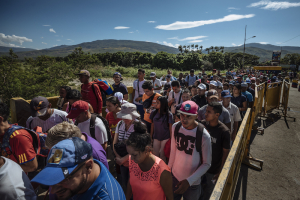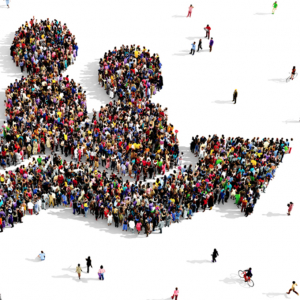Indicators in this domain assess the extent to which migrants have the same status as citizens in terms of access to basic social services such as health, education, and social security. It also describes the rights of migrants to family reunification, to work, and to residency and citizenship. The ratification of the main international conventions is also included within this domain.
Indicators in this category look at the extent to which migrants have access to certain social services such as health, education and social security. They also examine measures to ensure integration and access to work.
Indicators in this domain assess countries’ institutional, legal, and regulatory frameworks related to migration policies. Domain 2 also reviews the existence of national migration strategies that are in-line with development, as well as institutional transparency and coherence in relation to migration management. This domain also investigates the extent to which governments collect and use migration data.
Indicators in this category assess the institutional frameworks of cities for migration. This area also examines the existence of migration strategies consistent with development objectives, as well as institutional transparency and coherence in migration management.
This domain focuses on countries’ efforts to cooperate on migration-related issues with other states and with relevant non-governmental actors, including civil society organizations and the private sector. Cooperation can lead to improvements in governance by aligning and raising standards, increasing dialogue and providing structures to overcome challenges.
Indicators in this category focus on cities’ efforts to cooperate on migration issues with the national government as well as other cities and relevant non-governmental actors, including civil society organizations and the private sector.
This domain includes indicators on countries’ policies for managing the socioeconomic well-being of migrants, through aspects such as the recognition of migrants’ educational and professional qualifications, provisions regulating student migration and the existence of bilateral labour agreements between countries. Indicators equally focus on policies and strategies related to diaspora engagement and migrant remittances.
Indicators in this category assess cities’ initiatives in terms of international student mobility, access to the labour market and decent working conditions for migrant workers. Aspects related to diaspora engagement and migrant remittances are also included in this domain.
This domain studies the type and level of preparedness of countries when they are faced with mobility dimensions of crises, linked to either disasters, the environment and/or conflict. The questions are used to identify the processes in place for nationals and non-nationals both during and after disasters, including whether humanitarian assistance is equally available to migrants as it is to citizens.
Indicators in this category examine the type and level of readiness of cities to deal with aspects of mobility crises. The questions focus on the processes in place for citizens and non-citizens both during and after disasters, especially if humanitarian assistance is available for migrants and citizens.
This domain analyses countries’ approach to migration management in terms of border control and enforcement policies, admission criteria for migrants, preparedness and resilience in the case of significant and unexpected migration flows, as well as the fight against trafficking in human beings and smuggling of migrants. It also assesses efforts and incentives to help integrate returning citizens.
Indicators in this category look at the cities’ approaches to migrant safety as well as return and reintegration policies and the fight against trafficking in persons.
This Profile describes examples of well-developed areas and areas with potential for further development of the migration governance structures of the City of Málaga (Spain), as evaluated through the six domains of the Migration Governance Indicators (MGI). These address migrants’ rights, a “whole-of-government” approach, partnerships, socioeconomic well-being of migrants, the mobility dimensions of crises, and safe and orderly migration.
Click the icons on the wheel to explore the key findings.
The Migration Governance Indicators (MGI) initiative is a policy-benchmarking programme led by the International Organization for Migration (IOM) and implemented with research and analysis from the Economist Intelligence Unit. Funding is provided by IOM Member States.
Migration governance: Examples of well-developed areas:
- The municipality of Malaga has taken measures to combat discriminatory practices affecting migrants relating to the provision of social services.
- The municipality’s Education Office implements national and regional legislation guaranteeing that foreigners have access to public education at the primary, secondary and vocational levels, without distinction by nationality.
- The Municipal Office for Foreigners provides specialized legal advice services for foreigners.
- Málaga has local intercultural mediation services to help resolve disputes between the general public and the migrant population.
Areas with potential for further development:
- Local authorities do not yet have a specific policy or strategy to combat hate crimes, violence, xenophobia and discrimination against migrants.
- The development of mechanisms to facilitate migrants’ access to local housing is an area with potential for improvement.
Migration governance: Examples of well-developed areas:
- The Málaga Foreign Action Plan 2021–2023 sets out the local migration strategy, describes concrete actions, and defines monitoring, evaluation and impact indicators.
- The Action Plan explicitly addresses the integration of migrants, is gender-sensitive and is aligned with international development agendas such as the Sustainable Development Goals (SDGs).
- The Citizen Participation, Migration, Foreign Action, Development Cooperation, Transparency and Good Governance Sub-office is responsible for coordinating municipal efforts to engage with diaspora groups in Malaga jurisdiction.
Areas with potential for further development:
- Enhancing vertical policy coherence on migration-related issues is seen as an area with potential for development.
- The establishment of a municipal coordination board or space involving all migration-related institutions, organizations and associations in Malaga is an area to be strengthened.
- Regular training of public local officials on cultural sensitivity is an area with potential for further development.
Migration governance: Examples of well-developed areas:
- The municipality works with civil society organizations to implement migration-related policies and programmes.
- The municipality also works with private sector organisations on migration issues.
- Since 2020, Málaga has participated in the easyRights initiative, which aims to facilitate understanding of and access to the services to which migrants are entitled.
- Málaga is part of multiple international networks for the exchange of knowledge and best practices on migration.
Areas with potential for further development:
- Formal collaboration with migrant associations in agenda-setting and implementing local policies is an area with potential for development.
- There is no indication of formal collaboration with representatives of the Málaga diaspora or expatriate communities in agenda-setting and implementing local policies and programmes.
Migration governance: Examples of well-developed areas:
- Málaga local authorities implement specific programmes to promote and facilitate the inclusion of migrant workers in the labour force.
- There are several initiatives at the local level to promote gender equality for migrants in the workforce.
Areas with potential for further development:
- The municipality does not conduct evaluations to monitor the local labour market demand for immigrants, the local labour supply or the effects of emigration on the labour market.
- Local employment promotion programmes do not focus on attracting migrant workers or promoting the employment of foreign residents in the public sector.
- The implementation of specific local programmes to support financial literacy or promote the financial inclusion of migrants is an area with potential for development.
Migration governance: Examples of well-developed areas:
- The Civil Protection Service of the municipality implements relief measures and provides assistance to the public in disaster situations, regardless of nationality.
- The Municipal Reception Centre is a temporary public residential facility that provides specialized services to homeless people and migrants in emergency situations.
- The municipality coordinates with key players, such as consulates, to provide assistance to foreigners in Málaga in the event of a local emergency.
Areas with potential for further development:
- The development of a disaster risk reduction strategy containing specific provisions to prevent and address the impacts of disaster displacement is an area with potential for development.
- The Strategy to Protect Málaga’s Coastline 2020–2045, an instrument for the active prevention of climate change, does not mention displacement or migratory movements.
- The Foreign Action Plan 2021–2023, which defines the local migration strategy, does not set out reintegration strategies for migrants who left the city during a crisis.
Migration governance: Examples of well-developed areas:
- Local authorities have taken steps to facilitate the arrival of refugee groups under their jurisdiction, including planning for the resettlement of refugees.
- The local police force receives specific and regular training in matters related to the migrant population and migration.
Areas with potential for further development:
- The development of municipal programmes to facilitate migrant integration is an area with potential for development.
- While some actions related to human trafficking are implemented, Málaga does not yet have a dedicated municipal agency or strategy to combat human trafficking, or specific measures to combat the labour exploitation of migrants.
- The establishment of specific prevention and assistance measures in cases of domestic and gender-based violence among the migrant population is an area with development potential.
- There is no local strategy and/or protocol for the identification of missing migrants and providing support for their families, nor is there a local body in charge of this issue.




